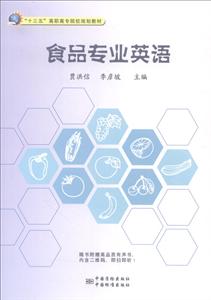-
>
公路車寶典(ZINN的公路車維修與保養秘籍)
-
>
晶體管電路設計(下)
-
>
基于個性化設計策略的智能交通系統關鍵技術
-
>
花樣百出:貴州少數民族圖案填色
-
>
山東教育出版社有限公司技術轉移與技術創新歷史叢書中國高等技術教育的蘇化(1949—1961)以北京地區為中心
-
>
鐵路機車概要.交流傳動內燃.電力機車
-
>
利維坦的道德困境:早期現代政治哲學的問題與脈絡
食品專業英語 版權信息
- ISBN:9787502645304
- 條形碼:9787502645304 ; 978-7-5026-4530-4
- 裝幀:一般膠版紙
- 冊數:暫無
- 重量:暫無
- 所屬分類:>>
食品專業英語 內容簡介
食品專業英語課程是高職高專院校食品類專業學生的一門重要的專業課。根據高職高專院校培養高技能型人才的培養目標,食品專業英語課程的主要任務是引導學生掌握一定的食品專業英語詞匯和專業術語,學會專業英語的翻譯技巧,提高學生專業英文文獻的查找、閱讀和翻譯水平,并能夠獨立翻譯和撰寫英文摘要。教材建設關系高校教學質量和教學效果的提升,做好教材建設、提高教學水平、豐富教學內容及促進教學方法改革具有重要而緊迫的意義。為適應新形勢,本教材緊密結合當代高職高專學生的具體情況和特點,運用新的信息技術和手段,在與企業一線技術和管理人員充分、深入合作的基礎上編寫完成。
食品專業英語 目錄
**節 翻譯的方法
第二節 翻譯的難點
Unit 2 Nutrients
Summary
Reading Material 1 Carbohydrates
Reading Material 2 Proteins
Reading Material 3 Lipids
Reading Material 4 Vitamins
Reading Material 5 Minerals
Unit 3 Food Raw Material
Summary
Reading Material 1 Eggs
Reading Material 2 Cerea1
Reading Material 3 Meat
Reading Material 4 Fruit and Vegetables
Reading Material 5 Legume
Reading Material 6 Milk
Unit 4 Flld Processing Technology
Reading Material 1 Bread Processing Technology
Reading Material 2 Vegetable Processing Technology
Reading Material 3 Sausage Processing Technology
Reading Material 4 Milk Products Processing Technology
Unit 5 Food Preservation
Summary
Reading Material1 Food Preservation by Drying
Reading Material 2 Food Preservation by Pickling and Curing
Reading Material 3 Food Irradiation
Reading Material 4 Food Preservation by Gas
Unit 6 Food Safety and Quality Control
Summary 1 Food Safety
Summary 2 Food Quality and Management
Reading Material 1 GMP
Reading Material 2 HAGGP
專業術語
參考文獻
食品專業英語 節選
Reading Material 3 Lipids Introduction Lipids are a diverse group of fats and fatlike substances. The word "lipid" isdefined as "any group of substances that are soluble in organic solvents such as hy-drocarbons, benzene, alcohols, ether, and chloroform, but are only sparinglysoluble in water, they constitute the principal structural components of living ceilswith proteins and carbohydrates. They also include some related and derived com-pounds" . Like the other two primary organic compounds carbohydrates and pro-teins, the lipids are also made up of carbon, hydrogen and oxygen.Types and Structures There are many different types of lipids, and each of them has different char-acteristics. They include fats and oils, cholesterol, phospholipids and glycolipids. Fats and oils are available in a variety of forms. Butter, cooking oils marga-rines, salad oils, and shortenings are essentially all-lipid forms. Ingested fats andoils include not only those from obvious source but also those from invisible fat sources,such as cereals, cheese, eggs, fish, meat, milk, and nuts. Triglycerides are thechemical form in which most fat exists in food as well as in the body. It is also themain constituent of vegetable oil and animal fats. They are formed from a singlemolecule of glycerol, combined with three molecules of fatty acid. When the bodyrequires fatty acids as an energy source, the hormone glucagon signals the break-down of the triglycerides by hormone-sensitive lipase to release free fattyacids. Blood triglyceride levels spike right after we eat, levels drop over the nextfew hours as the triglycerides are taken up and used for energy. Those which are notneeded are immediately transported to fat cells for storage. Excess triglycerides inplasma are called hypertriglyceridemia. It's linked to the occurrence of coronary ar-tery disease in some people. Elevated triglycerides may be a consequence of otherdisease, such as untreated diabetes mellitus. Like cholesterol, the triglyceride lev-els can be detected by plasma measurements. These measurements should be made after an overnight food and alcohol fast. Cholesterol is a white crystalline substance,' C27H45OH, found in animal tis-sues and various foods. Cholesterol is a normally synthesized by the liver. A highlevel of cholesterol in the blood-hypercholesterolemia is a major risk factor for coro-nary heart disease, which leads to heart attack. One of the major uses ofcholesterol is the synthesis of bile acids. These are synthesized in the liver fromcholesterol and are secreted in the bile. They are essential for the absorption of fatfrom the contents of the intestine. The body uses cholesterol to produce many hor-mones, vitamin D, and the bile acids that help to digest fat, but it takes only asmall amount of cholesterol in the blood to meet these needs. If a person has toomuch cholesterol in the bloodstream, the excess may be deposited in arteries,causing them to become thicker, harder, and flexible so they are unable to dotheir job-transporting blood efficiently. The result is an increased risk for heart at-tack and other forms of heart disease, such as hardening of the arteries (athero-sclerosis). The amount of cholesterol in the blood can be measured by a simple,nearly painless blood test. This test measures your total cholesterol level as well asthe levels of cholesterol's two main components: low-density lipoprotein (LDL)and high-density lipoprotein (HDL). ……
- >
我與地壇
- >
伯納黛特,你要去哪(2021新版)
- >
經典常談
- >
有舍有得是人生
- >
詩經-先民的歌唱
- >
企鵝口袋書系列·偉大的思想20:論自然選擇(英漢雙語)
- >
隨園食單
- >
煙與鏡

















